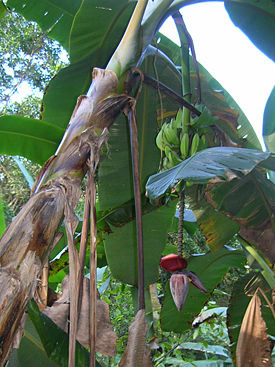Banana
Bananas are the fruit of a wide range of species in the Musa taxonomic genus.[1] Originally from Malaysia [1] in Southeast Asia and Australia, they have become so intrinsic to the diets of Africans and South Americans that many people from those continents (and many elsewhere) mistakenly believe them to be native. The overwhelming majority of bananas are shades of yellow when ripe, but there are also red, pink and purple species.
Most bananas eaten around the world are of the Cavendish variety, ultimately from India. They are a triploid version of the wild species Musa acuminata and consequently have the desirable seedless trait. Since they are sterile, all the Cavendish variety banana plants are clones from an original plant and consequently lack genetic diversity and are susceptible to disease. This and habitat destruction have led to fears amongst the scientific community that the days of the banana are numbered. A further problem is that all new plants must be grown from cuttings - so new disease resistant hybrids cannot be made by breeding the Cavendish variety with wild relatives.[2]
Bananas in cuisine
Besides being eaten all over the world as a wholesome snack at any time of day, bananas lend themselves well to cooking. Some varieties are used as main courses and side dishes, many more are the chief ingredients in snacks and desserts including a wide array of puddings and cakes. See banana/catalogs/list of banana desserts.[3]
Green bananas
Although all unripe bananas are green in colour, the term “green banana” usually refers to species of musa which are edible, but due to a lack of customary banana texture and sweetness are used for cooking rather than being eaten fresh. In southern Uganda, a variety called matoke was so widely used that it is now recognized and eaten all over the country. In many countries, green bananas are vital to the local economy as a cash crop. In India they are used in various parts - in the South as banana chips, in the East as an essential ingredient of shukto.
Banana leaves
In several cultures, banana leaves are used as wraps in which other foods are boiled, steamed, fried or roasted. The leaves keep the ingredients moist, flavourful and fragrant. See banana/catalogs/list of foods made with banana leaves.
Banana and plantain leaves are also used as plates, trays and packaging.
Plantains
Plantains are in the same genus as bananas but are a different species. In some languages, all musas are lumped together as differing varieties of “bananas”.
Bananas in horticulture
Bananas make interesting specimen plants. They are tropical plants, and therefore are a challenge and a talking point when grown in temperate areas. They therefore have a lot of interest for gardeners. Some varieties of banana can survive in sub-tropical climates, others can be successfully grown indoors in pots or tubs. A recent (2007) segment on the Gardening Australia television programme featured a very tall, fruiting banana tree growing in the gardener's living room!
Nutritional facts
Bananas are rich in iron and potassium salts. Milk and bananas therefore complement each other and form a sort of complete food. The rich content of potassium salts make it a part of recommended diet for hypertensive patients. Bananas are extremely low in fat and are a good source of fiber. A medium-sized banana contains approximately 105 calories.[4]
Notes
- ↑ The naming of species in the genus Musa, family Musaceae, is a complex business. See more, including the taxonomic history, at Musa.
- ↑ New Scientist: 'A future with no bananas?'. 13th May 2006. Login required to access the full article.
- ↑ See also banana.com for recipes.
- ↑ Nutrition Facts and Analysis for bananas, from NutritionData.com. Retrieved on 2009-02-05.
